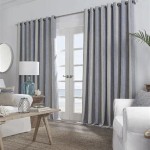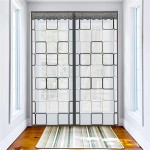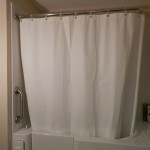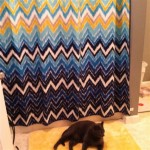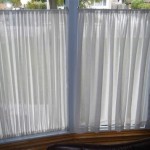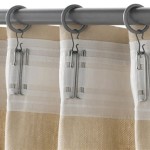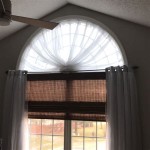Adjustable Curtain Rod 120 Inches: A Comprehensive Guide
An adjustable curtain rod, particularly one reaching 120 inches, offers a versatile solution for window treatments in a variety of settings. Its adaptability makes it suitable for both standard and unusually sized windows, providing a customizable and practical means of hanging curtains or drapes. This article will explore the features, benefits, considerations, and installation processes associated with adjustable curtain rods extending to 120 inches.
The inherent adjustability of these rods allows for adjustments in length, typically accommodating windows ranging from a specific minimum to the maximum length of 120 inches. This feature eliminates the need for precise measurements before purchase, offering a degree of flexibility rarely found in fixed-length rods. This is especially beneficial in situations where window sizes are not standard or where slight variations may exist. The ability to alter the rod's length simplifies the installation process and reduces the likelihood of requiring alterations or replacements due to incorrect sizing.
The material composition of an adjustable curtain rod plays a significant role in its durability, aesthetic appeal, and overall performance. Common materials include steel, aluminum, brass, and wood. Steel rods offer robust strength and are often coated with finishes to resist rust and corrosion. Aluminum rods are lightweight and corrosion-resistant, making them suitable for damp environments. Brass rods provide a classic and elegant look, while wood rods offer a natural and warm aesthetic. The choice of material should align with the overall décor of the room and the weight of the curtains to be hung. Heavy drapes require sturdier materials, such as steel or solid wood, to prevent sagging or bending.
The weight capacity of an adjustable curtain rod is a critical factor to consider, particularly when hanging heavy drapes or multiple layers of curtains. Exceeding the weight capacity can lead to bending, sagging, or even complete failure of the rod, potentially causing damage to the curtains, walls, or even injury. Manufacturers typically specify the maximum weight that the rod can safely support. This information should be carefully reviewed before purchasing the rod, and the weight of the intended curtains should be accurately assessed. Reinforcing the rod with additional support brackets may be necessary for heavier loads.
The aesthetic design of the curtain rod should complement the overall décor of the room and the style of the curtains. Adjustable curtain rods are available in a wide range of finishes, including brushed nickel, oil-rubbed bronze, chrome, black, and gold. The finials, which are the decorative end pieces of the rod, also contribute to the overall aesthetic. Finial styles range from simple and understated to elaborate and ornate. The choice of finish and finial style should create a cohesive and visually appealing look.
Adjustable curtain rods typically come with mounting hardware, including brackets, screws, and anchors. The quality and type of mounting hardware are crucial for ensuring the secure installation of the rod. The brackets should be sturdy and capable of supporting the weight of the rod and curtains. The screws and anchors should be appropriate for the type of wall material, such as drywall, plaster, or wood. Using the wrong type of hardware can result in a weak or unstable installation. In some cases, it may be necessary to purchase additional or upgraded hardware to ensure a secure and reliable installation.
The installation process for an adjustable curtain rod generally involves measuring the desired rod length, marking the positions for the brackets, installing the brackets, and then mounting the rod onto the brackets. Accurate measurements are essential for ensuring that the rod is level and properly positioned. Using a level to verify the horizontal alignment of the brackets is crucial. When drilling holes for the brackets, it is important to avoid any hidden pipes or wires. If necessary, a stud finder can be used to locate wall studs, which provide a more secure anchor for the brackets. After installing the brackets, the rod can be adjusted to the desired length and mounted onto the brackets. The curtains can then be hung onto the rod.
The type of curtains to be hung will influence the choice of curtain rod. Different curtain styles, such as grommet-top, rod-pocket, or tab-top curtains, require different types of rods or hardware. Grommet-top curtains, which have metal rings sewn into the top of the curtain, require a rod that can easily slide through the grommets. Rod-pocket curtains, which have a fabric casing at the top, require a rod that can be inserted into the casing. Tab-top curtains, which have fabric loops or tabs sewn onto the top, require a rod that can accommodate the tabs. The rod should be compatible with the specific type of curtains being used to ensure a proper fit and smooth operation.
Regular maintenance is essential for prolonging the lifespan and maintaining the appearance of an adjustable curtain rod. Dusting the rod and finials regularly will prevent the buildup of dirt and grime. If the rod is located in a damp environment, it may be necessary to occasionally wipe it down with a damp cloth to remove any moisture or condensation. Loose screws or brackets should be tightened to prevent the rod from becoming unstable. Applying a lubricant, such as silicone spray, to the rod can help to ensure smooth operation and prevent sticking or binding.
Key Point 1: Versatility and Adaptability
The primary advantage of an adjustable curtain rod, particularly one reaching 120 inches, lies in its versatility and adaptability. This feature caters to a wide range of window sizes, eliminating the need for custom-made rods or extensive alterations. Homeowners and renters alike can benefit from this flexibility, especially in residences with non-standard window dimensions. The ability to fine-tune the rod's length ensures a perfect fit, enhancing the aesthetic appeal of the room and optimizing the functionality of the window treatments. Furthermore, this adjustability simplifies the installation process, reducing the risk of errors and saving time and effort.
Consider a scenario where a homeowner is renovating a room and decides to replace the existing curtains. The new curtains are slightly wider than the old ones, but the window width remains the same. With a fixed-length curtain rod, the homeowner would face the challenge of either purchasing a new rod or altering the existing one. However, with an adjustable curtain rod, the homeowner can simply extend the rod to the required length, accommodating the new curtains without any additional expense or hassle. This adaptability makes adjustable curtain rods a practical and cost-effective solution for various window treatment needs.
Another advantage of adjustable curtain rods is their portability. When moving to a new home or rearranging furniture within a room, the curtain rods can be easily adjusted to fit the new window sizes. This eliminates the need to purchase new rods for each window, saving money and reducing clutter. The ability to reuse the same curtain rods in different locations makes them a sustainable and environmentally friendly choice.
Key Point 2: Material Selection and Durability
The material from which an adjustable curtain rod is constructed significantly impacts its durability, load-bearing capacity, and overall aesthetic. Different materials offer varying levels of strength, resistance to corrosion, and visual appeal. Steel, aluminum, brass, and wood are commonly used materials, each possessing unique characteristics. The selection of the appropriate material should be based on the intended use of the rod, the weight of the curtains, and the desired aesthetic of the room.
Steel rods are known for their exceptional strength and durability. They can withstand heavy loads without bending or sagging, making them ideal for hanging thick drapes or multiple layers of curtains. Steel rods are typically coated with protective finishes, such as powder coating or plating, to prevent rust and corrosion. These finishes also enhance the aesthetic appeal of the rods, offering a wide range of colors and textures. However, steel rods can be heavier than rods made from other materials, which may require stronger mounting hardware.
Aluminum rods are lightweight and corrosion-resistant, making them suitable for bathrooms or kitchens where moisture levels are high. Aluminum is also a relatively strong material, although it may not be as strong as steel. Aluminum rods are available in a variety of finishes, including brushed aluminum, anodized aluminum, and painted aluminum. They are a good choice for lightweight to medium-weight curtains and offer a sleek and modern aesthetic.
Brass rods provide a classic and elegant look. Brass is a durable and corrosion-resistant material that can withstand moderate loads. Brass rods are often polished to a high shine, giving them a luxurious appearance. However, brass can be more expensive than steel or aluminum. Brass rods are a good choice for formal living rooms or dining rooms where a traditional aesthetic is desired.
Wood rods offer a natural and warm aesthetic. Wood is a relatively strong material, although it may be more susceptible to damage from moisture or pests than steel or aluminum. Wood rods are available in a variety of wood species, each with its own unique grain and color. Wood rods can be stained or painted to match the décor of the room. They are a good choice for bedrooms or living rooms where a cozy and inviting atmosphere is desired.
Key Point 3: Installation and Mounting Considerations
The proper installation and mounting of an adjustable curtain rod are crucial for ensuring its stability and functionality. The installation process involves several steps, including measuring the window, marking the bracket positions, installing the brackets, and mounting the rod. Careful attention to detail is essential to prevent errors that could compromise the integrity of the installation. The type of mounting hardware used should be appropriate for the type of wall material and the weight of the curtains.
Before beginning the installation process, it is important to gather the necessary tools and materials. These typically include a measuring tape, a level, a drill, a screwdriver, screws, anchors, and the curtain rod and brackets. The measuring tape is used to determine the desired rod length and the bracket positions. The level is used to ensure that the brackets are installed horizontally. The drill is used to create pilot holes for the screws. The screwdriver is used to tighten the screws. The screws and anchors should be appropriate for the type of wall material, such as drywall, plaster, or wood.
The first step in the installation process is to measure the window width and determine the desired rod length. The rod should extend beyond the window frame on both sides to allow the curtains to be fully opened without blocking the window. The bracket positions should be marked on the wall, ensuring that they are level and equidistant from the center of the window. If possible, the brackets should be mounted directly into wall studs for maximum stability. If studs are not available, anchors should be used to provide a secure hold in drywall or plaster.
After marking the bracket positions, pilot holes should be drilled into the wall. The pilot holes should be slightly smaller than the diameter of the screws. The brackets can then be attached to the wall using screws. The screws should be tightened securely, but not overtightened, as this could damage the wall or the brackets. Once the brackets are installed, the curtain rod can be adjusted to the desired length and mounted onto the brackets. The curtains can then be hung onto the rod.

Utopia Alley 0 75 Inch Curtain Rod For Windows 86 To 120 Adjustable Drapery Rods Black D88z The Home

Utopia Alley D38sn 86 120 In Adjustable Curtain Rod With Round Finials Satin Nickel

Emoh 13 16 Quot Dia Adjustable 120 To 170 Triple Curtain Rod In Satin Nickel With Botany Finials Htpl 33 995 The Home

Utopia Alley D38sn 86 120 In Adjustable Curtain Rod With Round Finials Satin Nickel

Tension Curtain Rod 102 120 Inch No Drilling Adjustable Non Slip Telescoping

Utopia Alley D78rb 86 120 In Curtain Rod With Decorative Cap Finial Bronze

Pluscasa 1 Inch Dia Adjustable Paxe Curtain Rod 120 170 Black Size

1 Dia Adjustable Joline Curtain Rod 120 170 Inch Light Gold

Utopia Alley 3 4 Inch Curtain Rod Rods For Windows 86 To 120 Adjustable Drapery Gold Bedroom Living Room

Utopia Alley D38sn 86 120 In Adjustable Curtain Rod With Round Finials Satin Nickel

